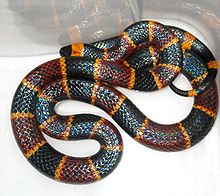Harlequin Coral Otter
| Harlequin Coral Otter | ||||||||||||
|---|---|---|---|---|---|---|---|---|---|---|---|---|

Harlequin Coral Viper ( Micrurus fulvius ) |
||||||||||||
| Systematics | ||||||||||||
|
||||||||||||
| Scientific name | ||||||||||||
| Micrurus fulvius | ||||||||||||
| ( Linnaeus , 1766) |

The harlequin coral otter ( Micrurus fulvius ), also known as the eastern coral otter , belongs to the species of coral otters ( Micrurus ) within the family of poisonous snakes ( Elapidae ). The species was first described in 1766 by the Swedish scientist Carl von Linné as Coluber fulvius . Micrurus fulvius is monotypic , so no subspecies are known.
features
The harlequin coral otter reaches a length of 51 to 76 cm, the largest recorded find was 120.7 cm. The body is long and slender, and the head is only slightly separated from the neck. The animal is markedly brightly colored and shiny ( warning costume ). About the middle of the black head is a wide, yellow band. The neck is also black. Black and red bands are distributed very regularly over the body, which alternate and are bordered on each side by a narrow yellow band. Red bands are missing towards the tail, black bands alternate with widening yellow bands. The belly is lighter in color, but also shows the drawing of the back. Occasionally, dark spots can be seen in the black rings, especially in specimens from southern Florida . Young snakes of the harlequin coral otters measure around 18 to 23 cm when hatching. They already show roughly the drawing of the adult animals.
Snake venom
The harlequin coral otter has an extremely strong snake venom , which is primarily composed of proteins , including an enzyme from the phospholipase A₂ group, which is responsible for the myotoxic properties of the venom and can destroy striated muscle fibers ( rhabdomyolysis ). Kidney damage cannot be excluded as an indirect consequence of rhabdomyolysis. In addition, the poison works postsynaptic as nerve poison (neurotoxin). After a bite, typical symptoms of poisoning occur in the form of swelling and pain around the bite site as well as gastrointestinal complaints. In addition to muscle pain, this is followed by neurological and central nervous complaints, particularly rapid onset of paralysis . If left untreated, death from respiratory paralysis can occur within 36 hours . Depending on the patient's condition, special antivenins are used . In addition to polyvalent immune sera, the specific serum "Wyeth Antivenin Micrurus fulvius " is available. Despite its high toxicity, bite accidents caused by this snake are very rare.
Way of life
The harlequin coral otter leads a hidden way of life. It is a ground-dwelling poisonous snake, which is particularly active during the early morning twilight, but also at night. During the day it is hardly in the sun, but occasionally roams around in the midday sun. It often hides under rubble, wood, leaves, palm stumps or the like. It mainly prey on slim lizards and smaller snakes. It reproduces oviparously (laying eggs). The clutch is hidden in leaves, for example, and can contain between 2 and 12 eggs.
distribution
The main habitat of the harlequin coral otter is in the southeastern United States . It runs through all of Florida and all the way to Texas . To the south, the distribution extends to northeast Mexico . The snake inhabits a variety of habitats , including pine forests and the tropical liana forests of Florida, also known as "Hammlocks". The harlequin coral otter is listed as "not endangered" in the IUCN Red List .
Systematics
The harlequin coral otter was first described by the Swedish scientist Carl von Linné as Coluber fulvius in 1766 .
A very similar species is the Texas coral otter ( Micrurus tener ), which until recently was classified as a subspecies of the harlequin coral otter as a result of studies by Crother et al. (2000), Collins & Taggart (2002) and Campbell & Lamar (2004) received species status.
swell
Individual evidence
- ↑ Micrurus fulvius in The Reptile Database ; Retrieved September 6, 2011.
- ↑ Chris Mattison: Encyclopedia of the Snakes , blv Verlag, P. 132. ISBN 978-3835403604 .
- ↑ Toxicological Department, Rechts der Isar Clinic, Munich: Micrurus spp.
- ↑ Dr. Dieter Schmidt: Atlas snakes , Nikol Verlag. ISBN 978-3-86820-011-9 .
- ↑ a b IUCN Red List: Micrurus fulvius
literature
- Roger Conant, Joseph T. Collins: Reptiles and Amphibians. Eastern / Central North America. Peterson Field Guides, ISBN 978-0-395-90452-7 .
- Mark O'Shea: Venomous snakes. All species in the world in their habitats. Franckh-Kosmos Verlag, Stuttgart 2006, ISBN 3-440-10619-5 .
